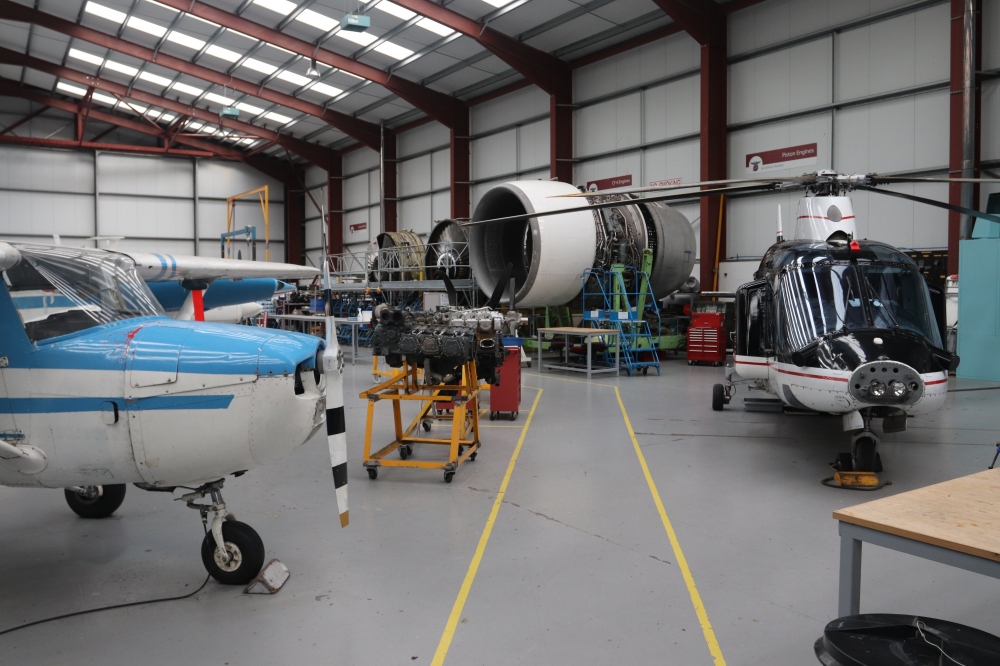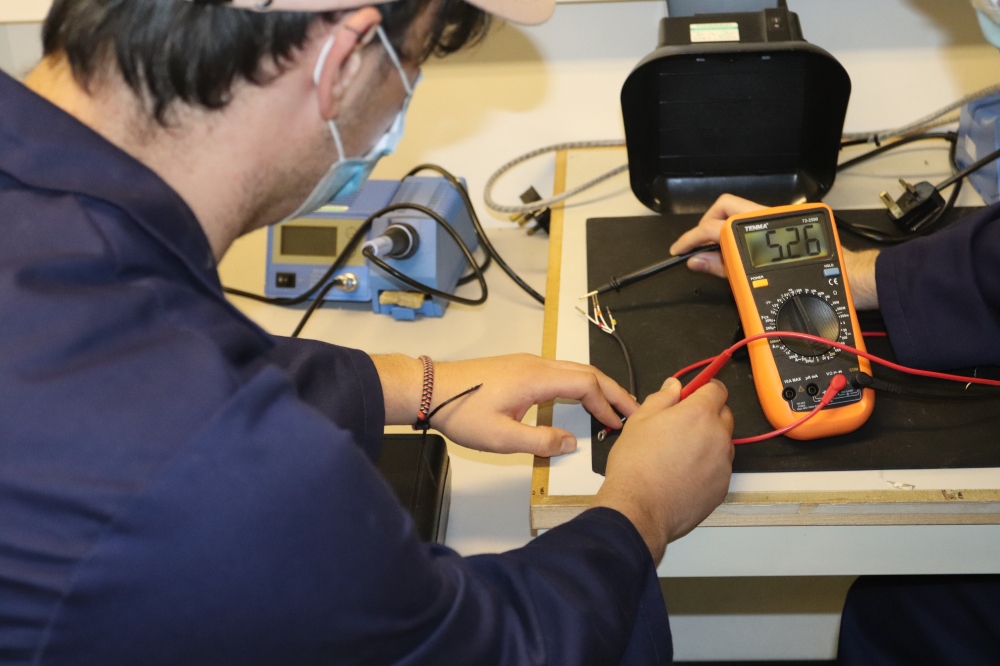A Day in the Life of an Air Service Training Student
This blog article has been written from the viewpoint of Foundation Apprentice Eilidh McDonald who is undertaking project work with AST as part of her coursework.
Have you ever wondered what a day in the life of an Air Service Training student (AST) is like? I took the opportunity to visit AST at its hangar facility, at Perth Airport, Scone, to find out.
The people that I met, including students and instructors, made AST stand out from the crowd. I visited Perth Airport to interview two students and one of AST’s instructors as well as take some photographs of the facilities available, including the Hangar, workshops, and classrooms.
The entire EASA training course has a duration of 2400 hours and is comprised of 60% theory and 40% practical; as you can see for nearly half of the course the students will be involved in practical activity either on aircraft or in workshops. Each training module has a set number of hours delivered according to the course structure as approved by UK CAA (UK Civil Aviation Authority) and EASA (European Aviation Safety Agency) approvals held by AST. Students study the theoretical aspects and, where applicable, test that theory with practical workshops. Practical skills are developed, and competency assessed in various subjects including electrical wiring and interconnection, basic sheet metal work, engine servicing and fault diagnosis and aircraft inspections. Examinations and Formal Assessments are delivered at the end of each training phase providing the student has made satisfactory progress and has achieved the required 90% attendance levels.
A typical day starts at 0900 and ends at 1630 with activity dependent on what point the students are at in their course. Each instructor has developed their own unique teaching style but always ensure that the required learning is delivered to the students. Breaks are set for the morning and afternoon as well as a lunch break around mid-day. Timings for breaks and lunch are dependent upon the activity being carried out and the instructor shall pick the most suitable point to stop the learning closest to the standard break times.
There is a set time for practical work that is not overly pressured, and people can work at their own pace to ensure the work is not rushed and individual skills are developed.
In the classroom, there are strict times to complete class work and assessments, unlike the practical work. The practical work is developed slowly because not everyone is familiar with the tools and it might be difficult for some. AST tends to allow more flexibility when it comes to practical as everybody develops their skills at their own pace. When working on aircraft it is important to take your time in undertaking repairs/checks, work should be of a high standard and completed safely and correctly.
In theory classrooms within the Hangar, there are occasions when sometimes it can be easier to take a walk onto the hangar floor and see a component up close to gain a clearer understanding of how it works. The AST Lecturers have different teaching techniques amongst the team and they will interact with the class and ask open questions to establish learning.
In the workshop, students go into pairs and the lecturers would give a work and safety briefing at the beginning of the lesson/day, so they would be told what to do and what not to do, and the basic plan for the day. The instructors will guide students through but once they get their head around it, the instructor would leave the students to it but still go around and check.
The students have tasks of inspecting, troubleshooting, removal and refitting, the instructor is making sure that the students are getting to know what it would be like to be in a work environment. The type of work they do depend on what stage of the course the students are at.
There is a hand skills workshop, which would show students how to use tools safely and correctly and the techniques used, after that they would be given projects to do. One of the first projects they did was to make a steel block into a step. They would use basic skills and use techniques that they had learned to complete the project; it would usually take a week to complete it. Some of the tasks may take longer than others, this will all depend upon the complexity of the task but also some of the students may already be comfortable using the hand tools. Students got projects cards and work through them. Another project they did was to make steel brackets, they would be using new tools and techniques.
In an electrical workshop, they learn how to crimp, as well as use new tools such as a soldering iron and voltmeters, then get given new projects to work on them.
In AST, there are students from all over the world, most of the students are international. It can be very difficult studying in a foreign country. For some other students it is the first time that they have moved from their native country and it can be an unsettling time adapting to new surroundings, climate etc. Shortly after starting to train the students will also face their first EASA Part 66 examinations. It is quite a lot of effort that the students must put in during training as each EASA Part 66 Examinations requires a minimum grade of 75% to successfully pass a module examination.
There are at least 15 different flags of the different countries the students are from. Since the students are from a different country, there can be a language barrier initially. For some students, they found it hard at the beginning, but they overcame the problem quickly as they become more accustomed to English language and dialects.
Anna Salva Macallan is doing an EASA Part 66 Approved Basic Training course and she is studying towards a Category ‘B1.1’ License. She is the only female in her class, although there are other females in other courses, all together there are 7 female students studying with AST.
AST is encouraging more woman to do courses at AST and get involved in engineering. There has never been an issue or difficulty experienced as AST is not that type of environment, everybody is encouraged to get along and support each other. Anna expresses that she has not felt discriminated against because of being the only female in her class and that everyone in the class has bonded well and become friends. Only problem is the overalls are not best fitting, as they are slightly too long. Anna picked engineering because she had done a bit of flying previously and was working in various other sectors. She did not find anything interesting and would always keep coming back to aviation. Anna had some time off and went overseas, she did some research and came across engineering and then AST. Her favorite aspect of the course is the mechanical aspects, such as the fuel systems and learning how they work. Anna enjoys the theory training and then going into the hangar to put in to practice the new knowledge she has learned.
“I PREFER TRYING TO OPEN IT MYSELF AND TRY FIX IT, IT FEELS KIND OF EMPOWERING WHEN I SOLVE THINGS MYSELF”
Jean–Luc Barra is also enrolled on an EASA Part 66 Approved Basic Training course, like Anna he is also studying towards the EASA Part 66 B1.1 License category. He picked aircraft engineering because it was a family thing, his father was an engineer, most of his cousins are pilots and engineers, so aviation is the field of the family.
Jean-Luc is from Seychelles, so he moved to Scotland to do this course, he has travelled a bit before, so having to adapt to a foreign country is quite familiar to him. Jean-Luc chose AST in Scotland because he was doing a diploma back in Seychelles, in motor vehicle engineering and out of the entire school he got picked out of top five best students.
Jean-Luc has gained aircraft maintenance experience working for Seychelles People’s Defence Force and doesn’t find the course difficult because of his background, he has already started working on military aircraft and its quite familiar to him, for some students it is going to be more difficult because they don’t have the background experience. His favorite aspect of the course is doing practical work but his favourite theory subject would be aerodynamics.

James Rhead picked being a teacher in aeronautical engineering as he has had a history of working in aviation, since he joined the military in 1983, and spent the next 22 years there. Not by choice apparently, he was asked to help teach in the military which he later found he enjoyed. If a student were struggling, he would often speak to them, to find out what was wrong and offer a further explanation and example to aid learning. Since there are students from all over, there can be a language barrier. To overcome this, the instructor would usually slow there speech down, and try avoiding complex words. By the time the course has ended, they sometimes even develop an accent. For a lot of students, English is there second or third language. If a student has learning difficulties, Perth College UHI offers support, so the student would always have someone to help them. James told me that past students have come back to visit AST, there were some that did this course in the 1980’s. The friendships that are formed during the AST course would last a lifetime.
“WOULD YOU RECOMMEND THE AST COURSE TO FUTURE STUDENTS? I WOULD, I DEFINITELY WOULD. “

